CANON SLRs of the 1970's
(c) Frank Mechelhoff
NEW Aug. 2022
German Version


The Canon EF
(1973-1978)
Canon EF
is normally known as an SLR lens bayonet mount capable
of Autofocus, which have started in 1987 with the EOS cameras.
Previously it was the name of a semiprofessional SLR
camera, launched in Nov. 1973 and sold for five
years. Initial price was 89,500 yen w. FD 50/1.4 lens; 1978 at
Sears catalog USA $459.99, in Germany 1200 DM, so it was on
the more expensive side of SLR offerings. The EF camera can't
be used with EF-lenses, because in it's days it used FD-mount,
an outer bayonet which was offered by Canon between 1971 and
1990, and to which the EF mount isn't compatible at
all.
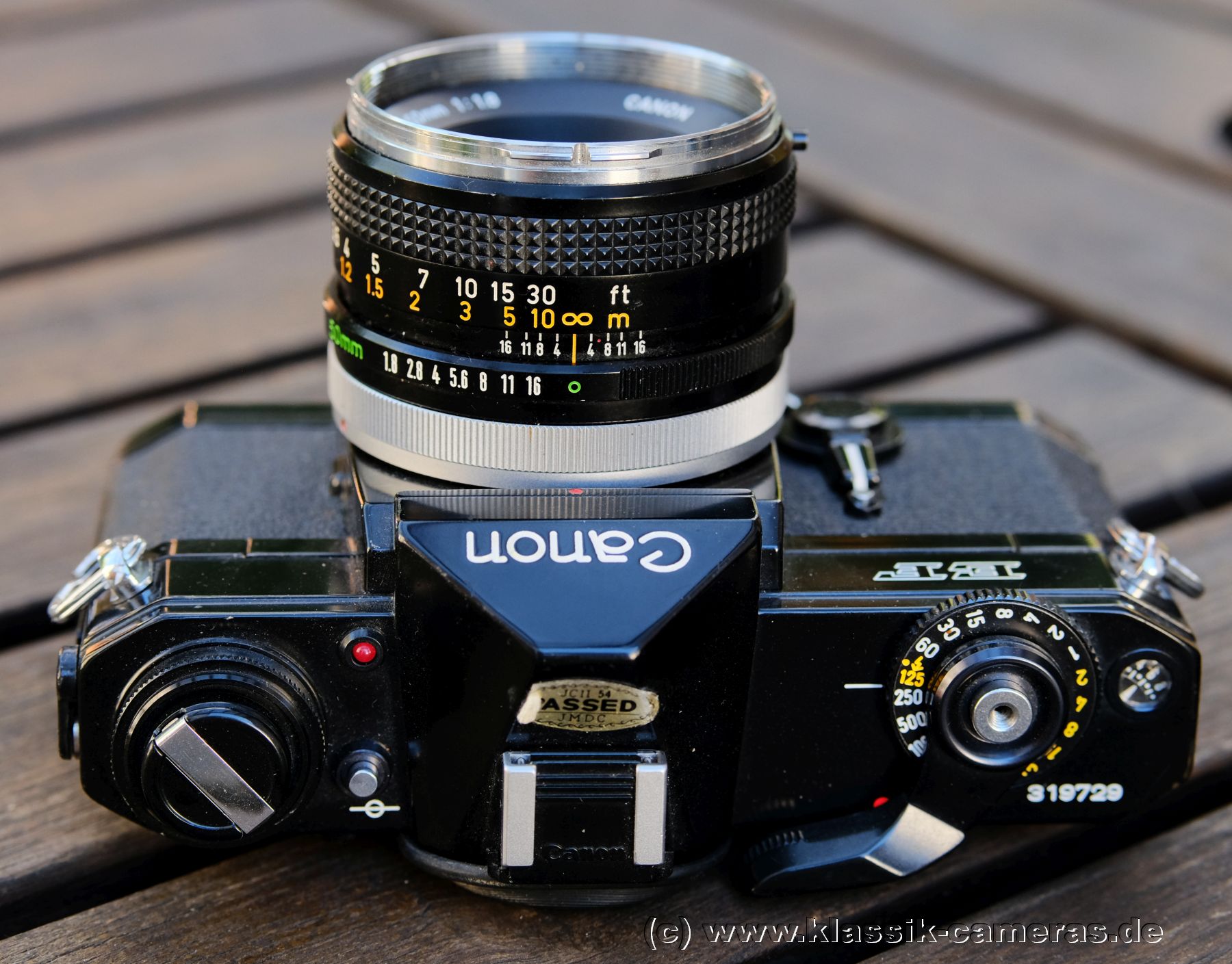
Canon EF was the first
Automatic Exposure (AE) SLR camera
offered by CANON, using shutter speed priority AE-mode,
mostly abbreviated as S ("shutter"), AE-S or Tv
("time value"). 1) It
incorporates an eletromechanical controlled, vertical travel
metal shutter of the type COPAL Square. This was the first
time CANON used a shutter of non-own production as well as
vertical travelling. Later COPAL shutters became very common
in SLRs. A silicon photocell, also quite new, faster
and more responsive (EV -2 to 18) than previuosly used
CdS-cells, was used for full-aperture center-weighted
averaging metering with all FD lenses. Fast shutter speeds
from 1/2 sec. to 1/1000 sec. and bulb were
mechanically-controlled, while slow speeds from 1 sec. to 30
sec. were electronically-controlled. So the EF can be used
without batteries with most common shutter speeds in manual
mode. AE functions naturally requiring batteries (2x PX625/old
Mercury cells or V625U/new with no concern about accuracy).
It has a big metering switch level right of the finder window,
so be sure not to forget to turn if off after usage, or your
battery will deplete. Moreover it has a nice big shutter speed
dial which protudes the fore camera edge, alike the Leica M5
before, or later on Nikon
FG, with the shutter button in the center.
It also has a mirror lock. The camera body
based on the large F-1 chassis, but didn't support a
motordrive. It's a large and heavy camera (151x96x48mm and
740g) but handles very well.
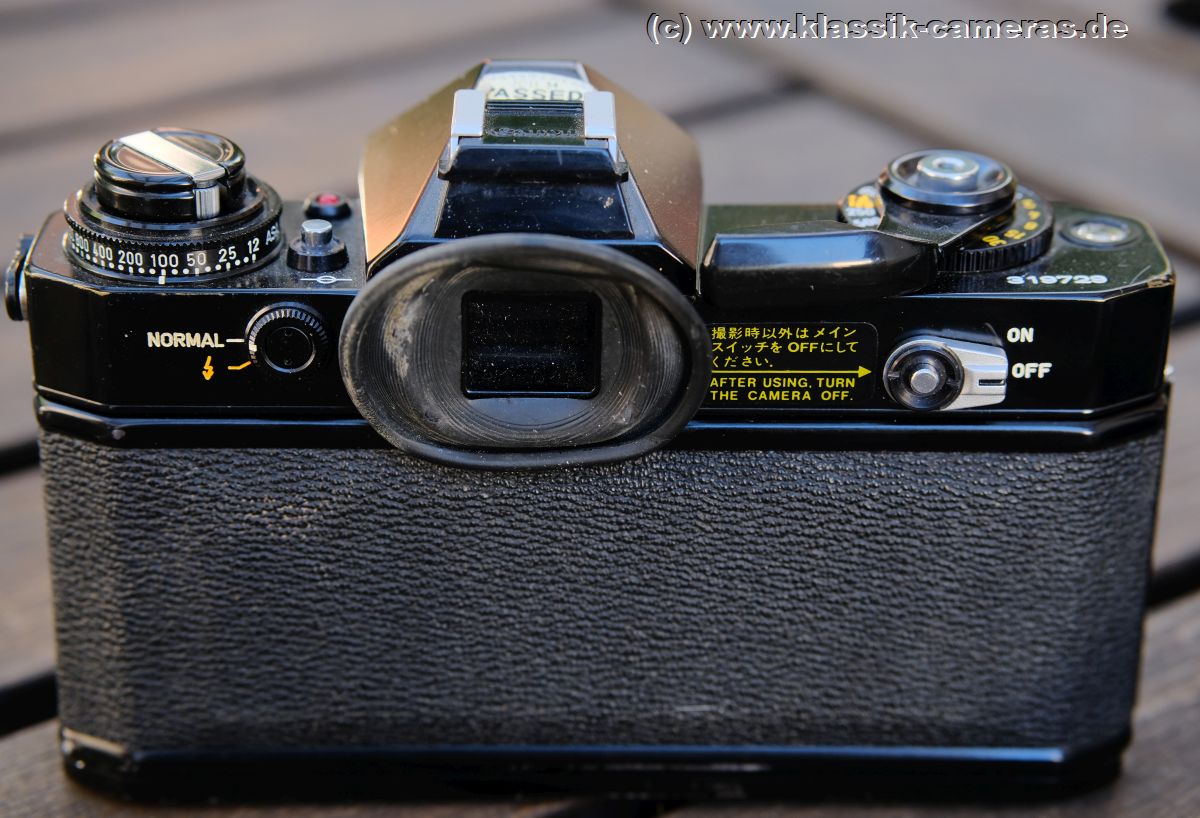
EF use with lenses
For AE
function, simply turn the aperture ring on any FD
lens to the green o
or A.
Earlier lenses (FL-mount) will work
with stop-down-metering but not AE.The original FD lenses,
introduced in 1971 (as well as their predeccessors
FL-mount/1964 and R-mount/1959) do not rotate in the
when attached to the camera; instead, a locking ring at the
base is turned to fix the lens. This was often criticized as
being slower than bayonet mounts of competing camera
makers. The counter argument, though, was that since the
lens/body mating surfaces did not rotate, there was also no
wear that could affect the critical distance from lens to film
plane. I personally like this "old" system much better than
newFD which replaced it after 20 years in 1979.

A very nice (yet un-illuminated) viewfinder information with
meter needle, providing the aperture range of the lens actual
attached, but it has no info (follower needle or warning) when
aperture is set manually (lack of lens aperture feedback). The
field of view is 92-93% at 0.82x magnification with a 50mm
lens.
Serial numbers seem to start with 100,000 and end about
424,000, estimated around 250,000 cameras made, a
quite successfull run, but quite low when compared with the
AE-1.
Production of EF
ended after their new "Semi-Pro"
model A-1 was launched, April 1978, but sales had faded since
start of the feature-rich middleclass camera AE-1 in 1976.
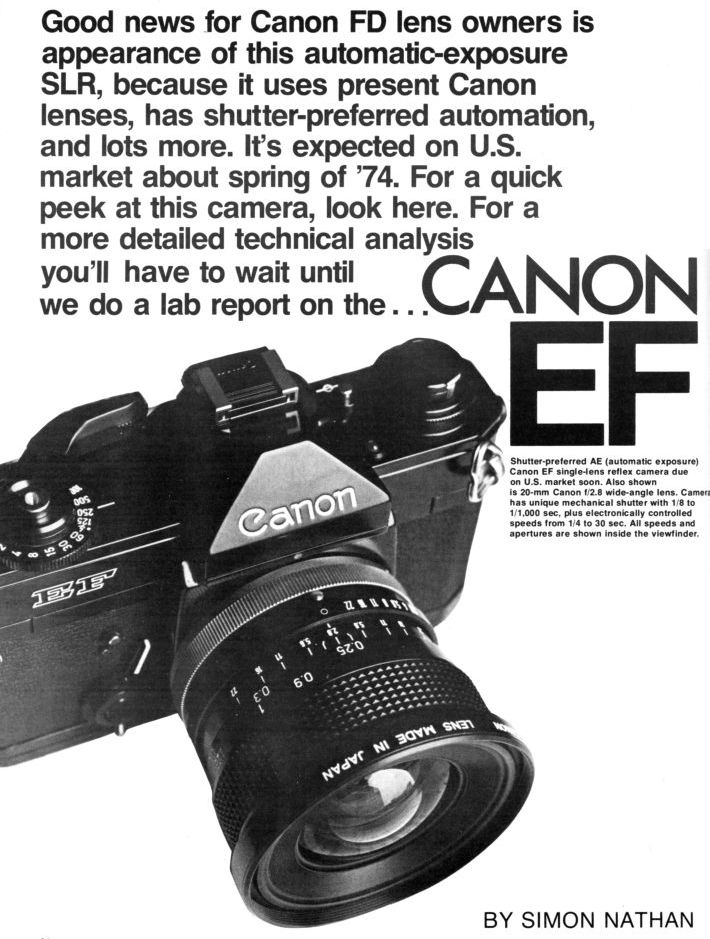
Overall subsumption of the EF
If you like to use/own a classic, full metal SLR
camera and AE/ Auto Exposure and don't fear some
more weight and size, there is definitely just one recommendation,
the EF. But, because of the same name as the newer
lens mount, they are difficult to find online.
When looking for a manual exposure SLR Canon for FD-mount, you
don't save weight and size: The Consumer class FT/FTb (740g)
is the same size and weight as the EF, and equal expensive
nowadays.
Eventually you prefer NIKON, there is a couple of
recommendations, heavy EL, lighter FE, FE-2 to F3. With manual
exposure only, go for FM, FM2 or FM2T/ Titan, all true
Classics (expect to pay more).
Link:
Short comparison of Canon EF, Nikkormat EL and Pentax ESII
PENTAX,
you may buy the K2 or LX. With
manual exposure only, go for MX, KX, or the economy models KM
and K1000, all of them ligther than 600g (the MX below 500g).
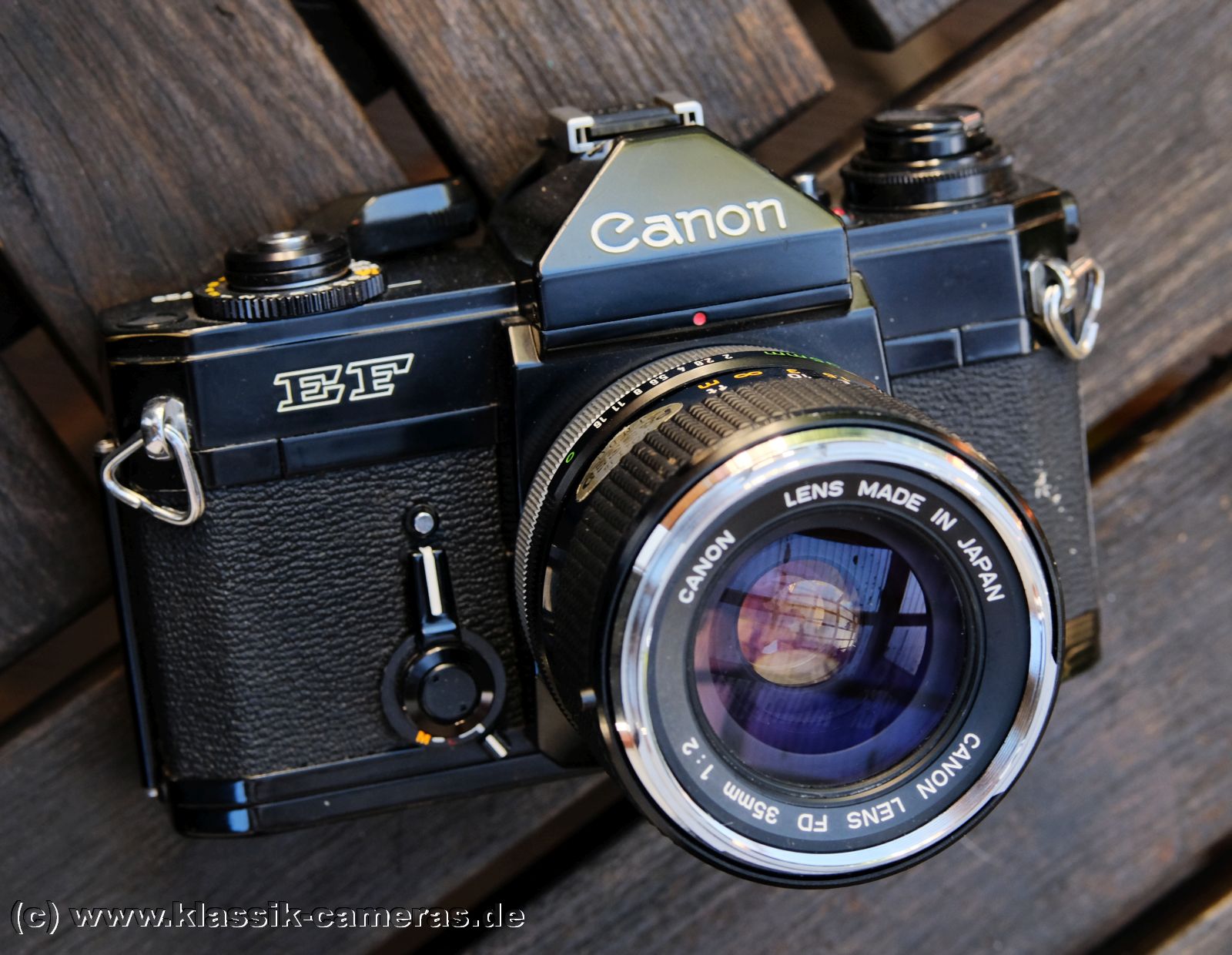
Chome nose FD lenses (Nov.
1971-1973)
The first FD lenses
available had a polished, chromed front ring
(lens hood bayonet and filter ring), which was designed with
use of the older lens hoods made of metal, which can scratch
later lenses with black paint front. So this series is now
called "chrome nose" (not to confuse with "chrom
ring" which means the dull, chrome breech lock ring at
the bayonet end typically for all FD-lenses before newFD
modification 1979). These lenses are considered the best
made of any FD lenses and probably all Canon lenses
ever, but they are the heaviest and largest as well
(even larger and heavier than Nikkor pre-AI lenses)
- Canon FD 24 mm 1:2.8
- Canon FD 28 mm 1:3.5
- Canon FD 35 mm 1:2 (Concave)
- Canon FD 35 mm 1:3.5
- Canon FD 50 mm 1:1.4
- Canon FD 50 mm 1:1.8
- Canon FD 55 mm 1:1.2
- Canon FD 55 mm 1:1.2 AL
- Canon FD 100 mm 1:2.8
- Canon FD 135 mm 1:3.5
My four chrom-nose
FD-lenses (marked in red above) are made between Dec.'71 (code
L1206) to Feb.'74 (code 0200), and the 50/1.8 (code M703 -
Jul.'72) came with my EF. All of them show no S.C.(Single)
Spectra Coated - or S.S.C. (Multi) Super Spectra
Coated-designation in beauty ring. My suggestion is the 35/2,
50/1.4 and both 55/1.2 were multicoated, since Canon started
not before March 1973 with the coating designation, but
started earlier with multicoating, as early as production
start of the 55/1.2 (1971/72)2).
It could easily be deteted when comparing them side by side
with their newer, S.S.C.-marked counterparts and looking at
the reflections from front in equal light. Single coated
lenses would show more "colorfull" reflections, whereas the
best coated lenses keep virtually black. Unfortunately my only
FD-lenses are "chrome noses" so I have nothing for direct
compare. But they look comparable with my Pentax SMC-lenses.
So from basic time line, most EF cameras were made when
"chrome nose" series was already over. But I like them
nevertheless with my EF. Next to them, I like the "chrome
ring" FD lenses better than the newFD with plastic
apterure rings. But they are still better when to compared
with what you get know new from Canon.
CANON AE-1 (Apr. 1976-1984)
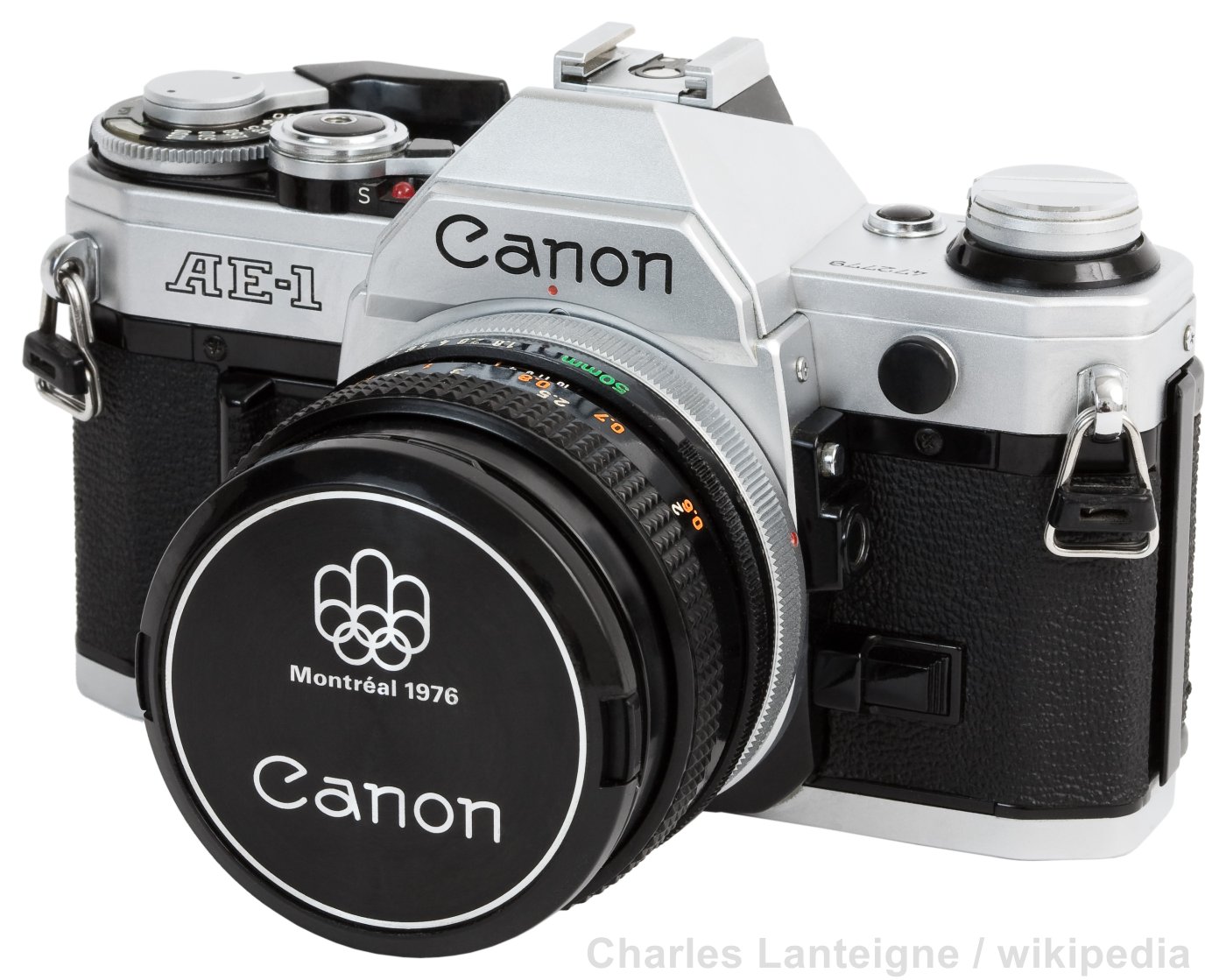 Image Charles Lanteigne-Wikimedia
Image Charles Lanteigne-Wikimedia
The Canon AE-1 was a great design, which stands in
line with the Canon P designed 17 years earlier, and an even
more great sales success (5.73 million cameras) and
one of the most important cameras for Canon. Canon was in some
business struggle in the mid 1970's, camera business running
low, they had too much products. The sales success of the AE-1
allowed Canon to expand their offerings in the FD-lens-series
and coming back astride with Pentax and Nikon.
Price of Canon AE-1 initially (Japan, April 1976 w. 50/1.4
lens) was 81,000 yen , in Germany 730 DM w. 50/1.8.
In 1980 it was listed for 423,- DM body alone (Fotoversand
Wuerzburg/ mail order, 11/80), compared to 385
DM Pentax ME-Super or 415 DM for a Minolta XG-9 or 495,-
(XD-5), but these other were launched after the Canon
AE-1. 1976 was also the year when the small Pentax ME
was launched- without shutter speed dial and manual mode - the
next bigger AE SLR was the Pentax K2, which was in the
"SemiPro" class and more expensive, and the bricks like Canon
EF, Nikkormat EL and Minolta XE-1, also more expensive. With its
classical size and outlook, neither too big, nor too
small, the AE-1 was exactly what most people asked for.
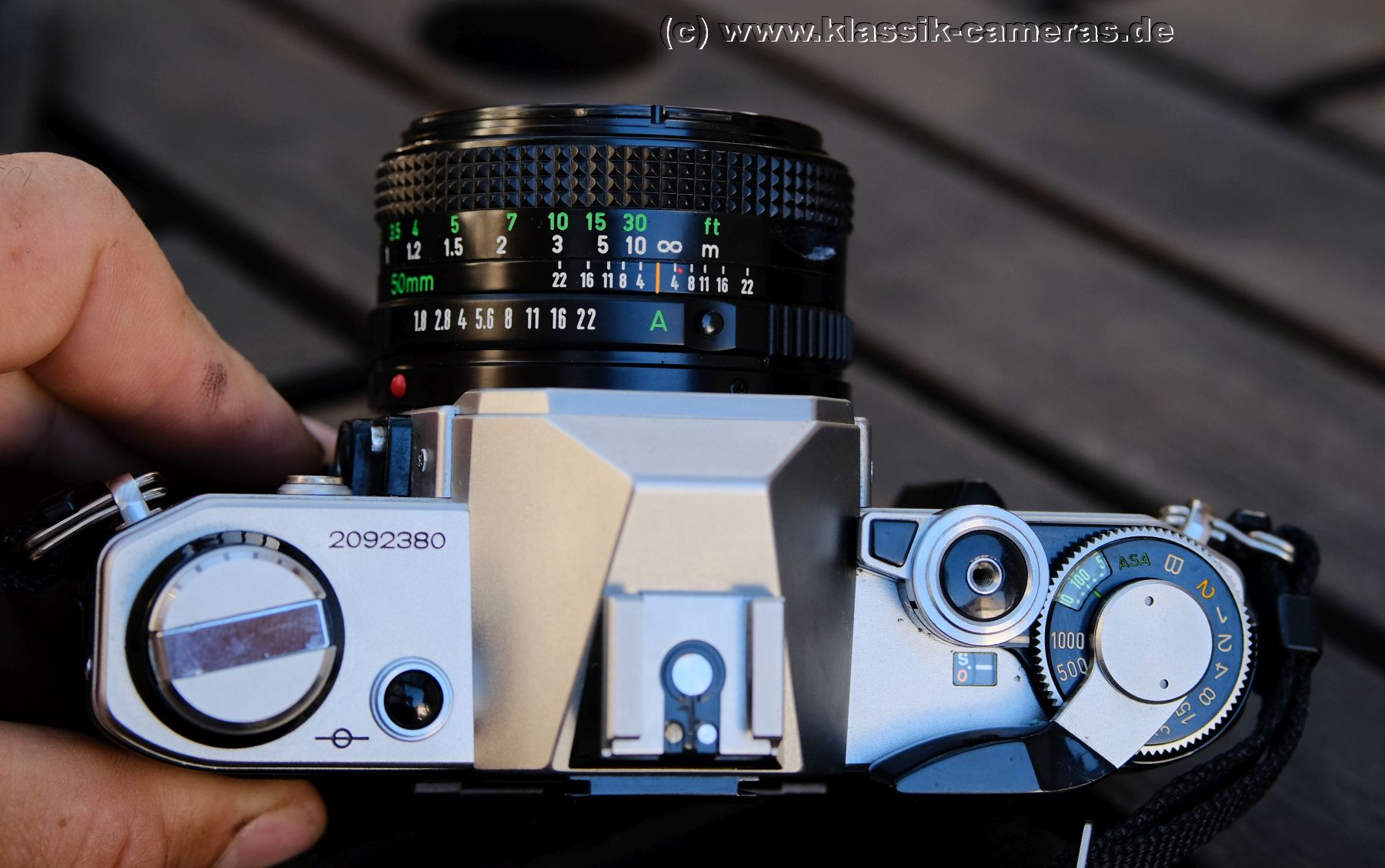
Canon AE-1 with
"newFD" (since 1979) standard lens with typical notchy plastic
aperture ring
Canon AE-1 was the first
microprocessor-equipped SLR. It needs a 4SR44
(6.2V) battery for all functions. Without battery, the camera
is a paperweight (not working at all!). When changing the
battery, watch out not to break the plastic battery cover! Exposure metering (EV 1-18) was standard in its
class, but 3 steps less extensive than EF's.
It also has a winder connection and created this as a standard
for middleclass-cameras (Power winder A2 with 2 frames per
second)
The
exposure control system consists of a needle pointing along a
vertical f-stop scale on the right side of the viewfinder to
indicate the readings of the built-in light meter
(center-weighted with a silicon photocell). Fo manually
setting it had neither a follower needle to indicating f-stops
set nor a plus/minus indicators for over/underexposure.
Dimensions and weight of the AE-1 was much smaller than the EF
- 141x87x47.5mm, 590g - about the same as the much more
mechanical (and expensive) Pentax K2, launched one year
earlier. Other than most Automatic Exposure SLRs of their era
it didn't used a metal blade sectional shutter (as made by
Seiko and Copal) but Canon kept - different from the EF -
their inhouse-made traditional cloth shutters with vertical
slit.
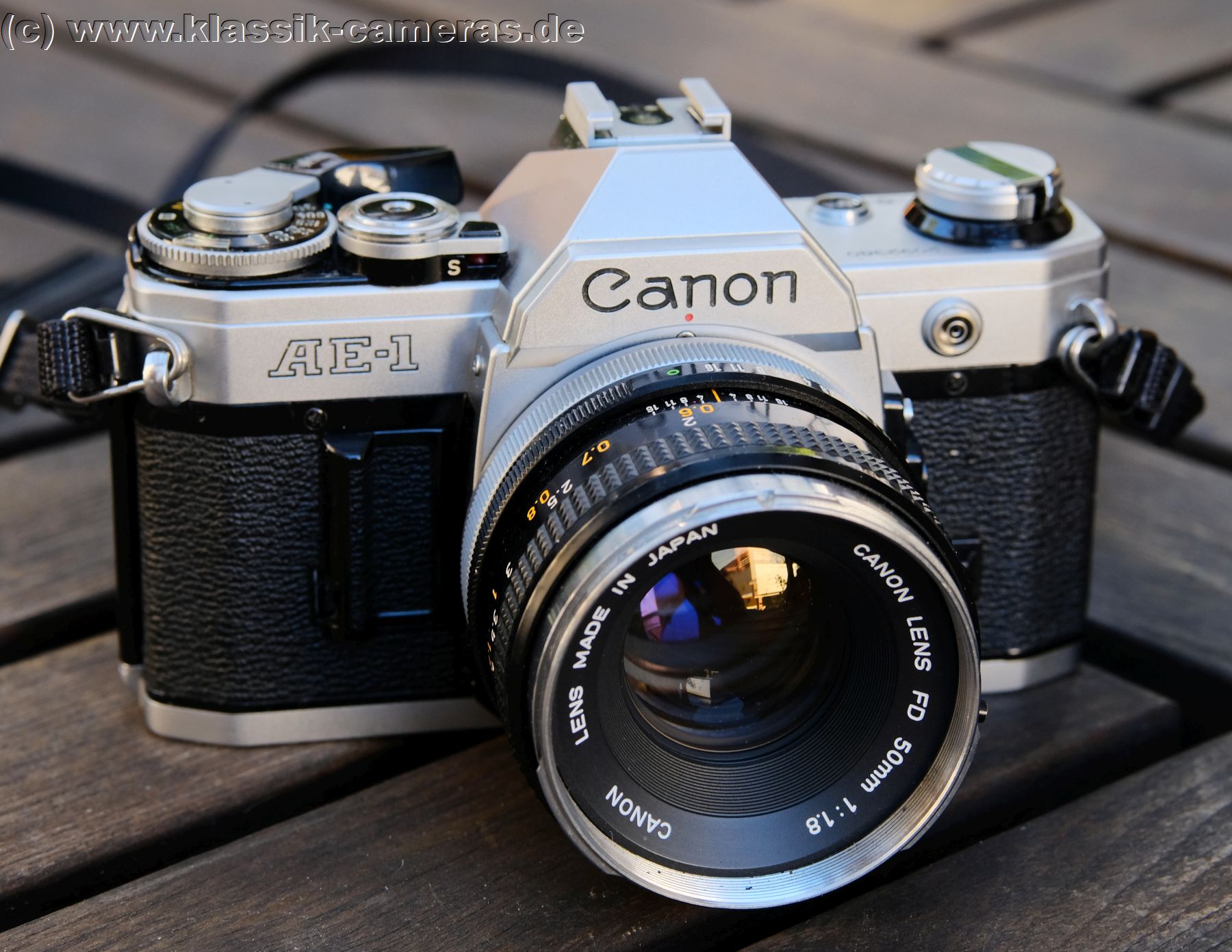
In order to keep production costs low, Canon designed the AE-1
to use a significant amount of structural plastic for a
lighter and cheaper camera. Canon went to great effort to disguise
the use of ABS plastic (injection-molded
acrylonitrile-butadiene-styrene) for the top panel finished
with either satin chrome (or black enameled) to give the look
and feel of metal. The bottom plate were made of metal.
Extensive use of electronics also allowed simpler modular
internal construction instead of mechanical linkages. Five
major and 25 minor internal modules reduced the individual
parts count by over 300. Modular construction, in turn,
allowed automated production lines to reduce cost. Cost
concerns also resulted in the use of plastic in some of the
moving/operating mechanisms. Since cost of labor increased in
1970's Japan, there was no other way to sell cameras at
previous price level, and the saturated SLR market demanded
Automatic Exposure and electric film winder capability for the
same price as former manually set cameras.
So CANON consequently developed most of their SLR offerings
around this successfull model (like Pentax did it with their
ME):
- AT-1
(1976) and AV-1 (1979) were econmy
models, about 1/3 cheaper than the AE-1 and providing less
finder informations.
- A-1 (1978)
was the high middleclass (not really a Semi-Pro)
model (DM 723,- in 1980) based on the same body, with manual, Aperture Priority, Shutter Priority,
and full Program mode - and a great stylish
7-segment digit display
- AE-1
Program came out in April 1981, adding combined aperture
and shutter speed priority AE and replaced the AE-1 in
long-term view. Sadly the big shutter speed dial of
the AE-1 was omitted here.
- AL-1 (1982), an interesting
camera based on the AT-1 with focus indicators added, so
it was important for development of Autofocus with Canon,
similar to the Pentax ME
F, which already had Autofocus when connected to a
special lens.
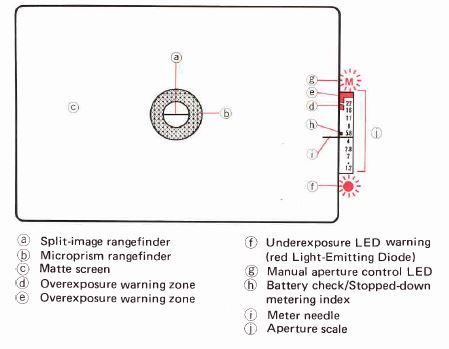
AE-1 Finder informations
Oberall subsumption of the AE-1
The Canon
A-series was succeeded since 1984 by the T-series
(T70; 1986 top model T90 inheriting the A-1) with motorized
film transport added, and a much more plasticy look. That's
when I (aged 20 back then) actually stopped buying new SLR
cameras because I didn't liked them (and had no feel to need
their new functions). So the AE-1 is the last CANON
camera following the design lines created in the late 1950's
with the CANON P, when CANON was full-bloiwn, stood in line
with NIKON, challenging LEICA.
Because of this, the AE-1 is a great camera for
vintage-style film use for people who (like me) in
general prefer Automatic Exposure function -- if you keep in
mind their limitations, and you don't mix it up with a
full-metall Semi-Pro camera like Pentax K2 or Nikon FE, but
benefit from virtues of smaller size and weight. Because of
the large shutter speed dial, I prefer it over the AE-1
Program. You don't want a lesser camera, like the AV-1 or
AT-1. You might like the A-1, with it's cult 1970's "electric
calculator red section digit LED readout" but it's
plasticy black, heavier and misses the beautiful clear topline
of the original AE-1. Also it's often squeels when fired
(known as Canon Cough).
1) The overall
first camera with automatic exposure (shutter priority) was
the German made Zeiss-Ikon
Contaflex Super B (1962), which was a Leaf-shutter-SLR
and didn't had TTL metering yet and worked with a selenium cell. The
first focal plane shutter SLR with AE (S) was the
mechanically controlled KONICA Autoreflex /Autorex (1965). In the
early 1970's there were some other focal plane shutter SLRs with aperture
priority (often abbreviated A or Av)
was the Pentax Electro Spotmatic (1971), Nikkormat EL (1972), and
Minolta XE-1 (1974). In 1973 there was no AE (S) camera
beside Canon EF.
Scan aus der Broschüre "Einführung in die Canon
F-1", Canon Inc., Tokyo (1972)

Image: Canon AE-1 (1976) and Canon P Rangefinder w.
50/1.4 (1959). Both cameras weight 590g and have the same size
(separate from AE-1 prism, but for the "P" you can conceive an
about equally sized light meter added on top)
Just look how perfect the typing of the old Canon lettering
was!
back
to CANON Main page
CANON V/ VI/ L camera






 Image Charles Lanteigne-Wikimedia
Image Charles Lanteigne-Wikimedia


